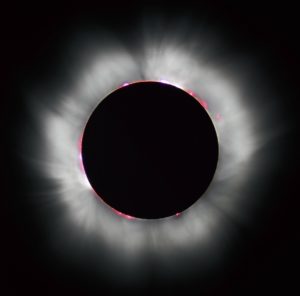While it’s a virtual instinct for us not to stare directly at the sun, the temptation to do so during a solar eclipse might lead some sky-gazers to let down their guard and throw caution to the wind.
The experts’ firm advice: Unless the eclipse is literally “total” — that is, the minute or two during which the sun is completely covered in shadow —don’t do it.
Online, the American Astronomical Society and American Academy of Opthalmology have issued this warning for those planning to view any partial or complete eclipse:
“Looking directly at the sun can seriously damage your eyes. Staring at the sun for even a short time without wearing the right eye protection can damage your retina permanently. It can even cause blindness, called solar retinopathy.”
Says Los Alamos, NM physicist and Rabbi Jack Shlachter, who plans on watching this month’s solar eclipse in Nebraska: “At any point during the eclipse, other than the brief minutes of totality, you cannot look directly at the sun without suffering real and permanent damage.”
In the “path of totality” where the eclipse will cover 100% of the sun’s visible surface, the window of opportunity for viewing the sun with unprotected eyes, Shlachter says, will be about two minutes and 15 seconds.
In areas outside the path of totality, where the eclipse will only be partial — including all of Colorado — viewers should absolutely not look directly at the sun without proper eye protection.
“For anybody who is not in the region of totality, the safest thing is to do a projection onto cardboard or some kind of material,” Shlachter says.
“You can also buy eclipse glasses that are heavily filtered. You want to be cautious with filters because they can get scratched or a pinhole can get through them.”
For those who choose projection, the safest choice for viewing, the website skyandtelescope.com has practical advice for creating projected images of the eclipse using pinhole, telescope and binocular methods.
For all eclipse viewers, the American Academy of Opthalmology has issued the following safety tips:
• There is only one safe way to look directly at the sun, whether during an eclipse or not: through special-purpose solar filters. These solar filters are used in “eclipse glasses” or in hand-held solar viewers. They must meet a very specific worldwide standard known as ISO 12312-2.
Keep in mind that ordinary sunglasses, even very dark ones, or homemade filters are not safe for looking at the sun.
• Carefully look at your solar filter or eclipse glasses before using them. If you see any scratches or damage, do not use them. Always read and follow all directions that come with the solar filter or eclipse glasses.
Help children to be sure they use handheld solar viewers and eclipse glasses correctly.
• Before looking up at the bright sun, stand still and cover your eyes with your eclipse glasses or solar viewer. After glancing at the sun, turn away and remove your filter — do not remove it while looking at the sun.
• The only time that you can look at the sun without a solar viewer is during a total eclipse. When the moon completely covers the sun’s bright face and it suddenly gets dark, you can remove your solar filter to watch this unique experience. Then, as soon as the bright sun begins to reappear very slightly, immediately use your solar viewer again to watch the remaining partial phase of the eclipse.
• Never look at the uneclipsed or partially eclipsed sun through an unfiltered camera, telescope, binoculars or other similar devices.
This is important even if you are wearing eclipse glasses or holding a solar viewer at the same time. The intense solar rays coming through these devices will damage the solar filter and your eyes.
• Talk with an expert astronomer if you want to use a special solar filter with a camera, a telescope, binoculars or any other optical device.
For information about where to get the proper eyewear or handheld viewers, visit the American Astronomical Society at https://eclipse.aas.org/eye-safety/eyewear-viewers.
Copyright © 2017 by the Intermountain Jewish News

















